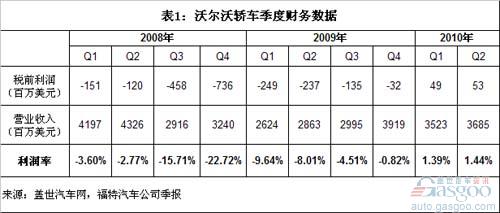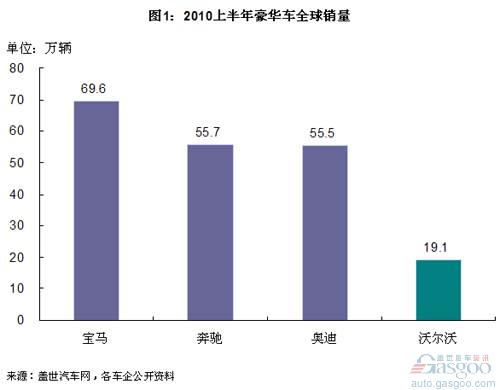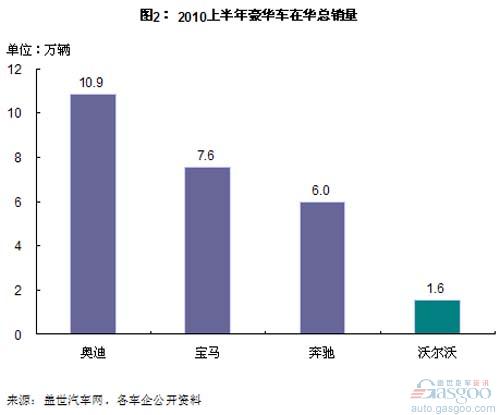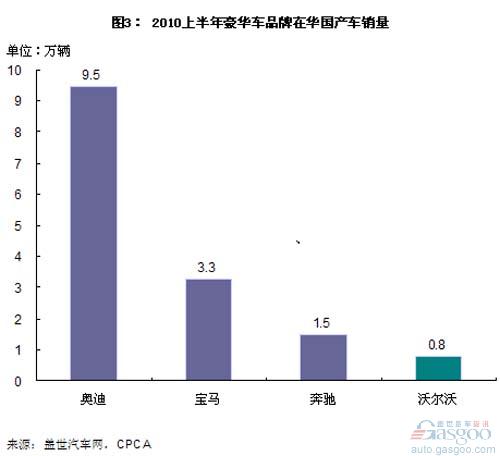Two consecutive quarters of profit margins are gradually rising
In the past three years, Volvo Car Corporation (hereinafter referred to as Volvo) has been losing money, but its loss ratio has gradually narrowed since 2009. (Regarding this, Gasgoo.com has approximately three years of sales and profit analysis of Volvo Cars.) Elaborated). From the fourth quarter of 2008 to the fourth quarter of 2009, Volvo’s (pre-tax) losses have decreased from US$736 million to US$32 million, and profit margins have gradually improved from -22.72% to -0.82%.
From the first quarter of 2010, Volvo has resumed profitability. In the first quarter and second quarter of this year, Volvo Cars achieved a pre-tax profit of 49 million and 53 million U.S. dollars, respectively, with profit margins of 1.39% and 1.44%, respectively. (See Table 1)

Its recovery profit is largely due to the gradual recovery of the global auto market, and Volvo may continue to maintain this kind of profit recovery in the second half of the year. If the new Volvo management team appointed by Geely Group has a good strategy, can seize the growth opportunities in the Chinese market, and bring higher sales to Volvo at a lower cost, its profit margin level will further increase.
Compared with the sales of the top three luxury car brands in the world, especially in China
According to Ford Motor Company's second-quarter financial report, Volvo’s global sales in the first half of 2010 were 191,000 units. This is in contrast with global sales of the world’s top three luxury car brands (hereinafter referred to as “the three major brandsâ€). The sales volume is only about 34% of the sales of Mercedes-Benz or Audi, and 27% of BMW sales. (See Figure 1)



In China, Volvo’s total sales (including imported cars) in the first half of the year were only 26.1% for Mercedes-Benz, 20.5% for BMW, and 14.3% for Audi; Volvo’s domestic sales were 53.3% for Mercedes-Benz, but only 24.3% for BMW, Audi. 8.4%. (See Figure 2, Figure 3)
In summary, the absolute value of Volvo's sales in China and the three major brands is not as great as that in the world, but the relative gap is actually even greater.
As Volvo's new domestic projects are still under planning and pre-construction, Volvo will not be able to increase domestic-car sales in the short term. If Volvo wants to increase sales in China as soon as possible, the fastest way is to increase imports and marketing of Volvo brand.
Compared with the three major brands, Volvo needs to increase its sales in China and also have more opportunities and support (from Geely Group). Although Volvo’s global sales are currently low, China’s share is about 8.13%, which is lower than that of Mercedes-Benz, BMW, Audi’s China sales (approximately 10.71%, 10.86%, and 19.57%, respectively), but the proportion of China’s sales in the future will be lower. Or continue to rise and gradually exceed Mercedes-Benz, BMW, in the long-term future, may also reach a higher proportion of Chinese sales than Audi.
Note:
1. In Table 1, the financial data for the second quarter of 2009 is adjusted data for 2010.
2. BMW sales in Figures 1 and 2 include BMW and Mini brand sales. Mercedes sales include sales of Mercedes, Smart, Maybach, and AMG brands.
Battery Hydraulic Cable Cutter
Cable Cutter ,Plastic Pipe Machinery ,Laser Cutting Machine,Other Metal Processing Machinery
Full-Automatic Busbar Machine Co., Ltd. , http://www.nbbusbartools.com